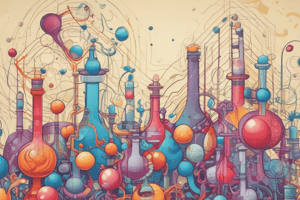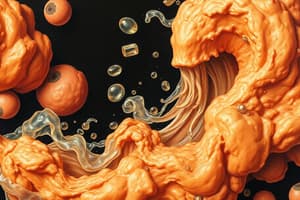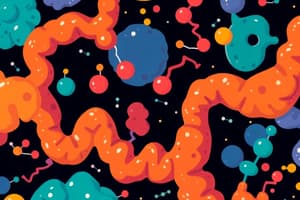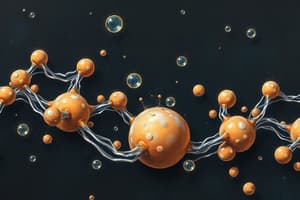Podcast
Questions and Answers
Considering the artwork provided, which nutrients are likely present in the still life?
Considering the artwork provided, which nutrients are likely present in the still life?
- Primarily carbohydrates and saturated fats.
- Only vitamins with very little protein or fat.
- Significant amounts of proteins and unsaturated fats. (correct)
- Mostly water and minerals with negligible proteins.
If the walnuts in the still life were replaced with apples, what change would be most significant?
If the walnuts in the still life were replaced with apples, what change would be most significant?
- Increase in the amount of proteins available.
- Decrease in the amount of unsaturated fats. (correct)
- Decrease in the amount of simple sugars.
- Increase in the amount of saturated fats.
Which of the following preparation methods is NOT suitable to improve protein digestibility of only the eggs?
Which of the following preparation methods is NOT suitable to improve protein digestibility of only the eggs?
- Boiling the eggs until both the white and yolk are solid.
- Scrambling the egg thoroughly at a high temperature. (correct)
- Lightly poaching the eggs to maintain a runny yolk.
- Frying the egg in oil until the whites are firm.
If someone is allergic to eggs, which of the following should they consume to get similar amounts of protein?
If someone is allergic to eggs, which of the following should they consume to get similar amounts of protein?
The artwork includes copper vessels. Although not a direct nutrient, which of the following is a potential health implication related to consuming food prepared in such vessels?
The artwork includes copper vessels. Although not a direct nutrient, which of the following is a potential health implication related to consuming food prepared in such vessels?
What three components define the structure of an amino acid?
What three components define the structure of an amino acid?
What primarily determines a protein's unique characteristics?
What primarily determines a protein's unique characteristics?
Why are some amino acids classified as 'essential'?
Why are some amino acids classified as 'essential'?
Under what circumstances might an amino acid be classified as 'conditionally essential'?
Under what circumstances might an amino acid be classified as 'conditionally essential'?
Which bodily function relies on proteins like actin and myosin?
Which bodily function relies on proteins like actin and myosin?
Which of the following is NOT a primary function of proteins in the human body?
Which of the following is NOT a primary function of proteins in the human body?
Which food source is considered a complete source of essential amino acids?
Which food source is considered a complete source of essential amino acids?
If someone primarily consumes incomplete protein sources, what dietary strategy can they employ to obtain all essential amino acids?
If someone primarily consumes incomplete protein sources, what dietary strategy can they employ to obtain all essential amino acids?
Flashcards
Proteins
Proteins
Large molecules made of amino acids essential for body functions.
Amino Acids
Amino Acids
Organic compounds that combine to form proteins, they are the building blocks of life.
Protein Functions
Protein Functions
Proteins serve various functions including structure, transport, and enzymatic activity.
Sources of Protein
Sources of Protein
Signup and view all the flashcards
Protein Synthesis
Protein Synthesis
Signup and view all the flashcards
Essential Amino Acids
Essential Amino Acids
Signup and view all the flashcards
Non-Essential Amino Acids
Non-Essential Amino Acids
Signup and view all the flashcards
Conditionally Essential Amino Acids
Conditionally Essential Amino Acids
Signup and view all the flashcards
Functions of Proteins
Functions of Proteins
Signup and view all the flashcards
Food Sources of Proteins
Food Sources of Proteins
Signup and view all the flashcards
Polypeptide
Polypeptide
Signup and view all the flashcards
Study Notes
Proteins
- Proteins are polymers made of amino acids
- Amino acids are molecules with an amine group (-NH₂), a carboxylic acid group (-COOH), and a side chain that differs in each amino acid.
- A polypeptide is a sequence of amino acids
- A protein is a polypeptide folded into a specific, complex 3D shape. This shape determines its function.
- Each protein has a unique amino acid sequence that defines its specific shape.
Amino Acids
- 20 amino acids are coded by DNA and used by living organisms.
- Essential amino acids must be obtained from food because the body cannot produce them.
- Non-essential amino acids can be produced by the body.
- Conditionally essential amino acids are normally produced by the body, but in certain conditions, they might need to be obtained from food. (Examples in the provided text)
Protein Functions
- Proteins have diverse functions in the body, including:
- Structure: Examples include keratin and collagen
- Enzymes: Examples include lactase
- Hormones: Examples include somatotropin and insulin
- Muscle contraction: Examples include actin and myosin
- Immune system: Examples include antibodies
- Transport and cellular communication: Example includes hemoglobin
- Energy source
Food Sources of Proteins
- Complete proteins contain all essential amino acids. Examples include eggs, meat, fish, milk products, soybeans, quinoa, and amaranth.
- Incomplete proteins lack one or more essential amino acids. Examples include legumes, grains, nuts, seeds, some vegetables, and some fruits. Combining incomplete protein sources can provide a full assortment of essential amino acids.
Review Questions
- What are the "building blocks" of proteins?: Amino acids
- What is the difference between essential, non-essential, and conditionally essential amino acids?: Essential amino acids must be obtained from food; non-essential amino acids can be produced by the body; and conditionally essential amino acids are normally produced but might need to be obtained from food under certain conditions.
- What are functions of proteins in the body?: The functions include structural components like keratin and collagen, enzymatic activities like lactase, hormonal roles like insulin and somatotropin, and more.
- What are the main food sources of proteins?: Complete proteins, such as eggs, meat, and milk; and incomplete proteins, such as legumes, grains, and nuts. Combining incomplete proteins can often provide all essential amino acids.
Studying That Suits You
Use AI to generate personalized quizzes and flashcards to suit your learning preferences.




